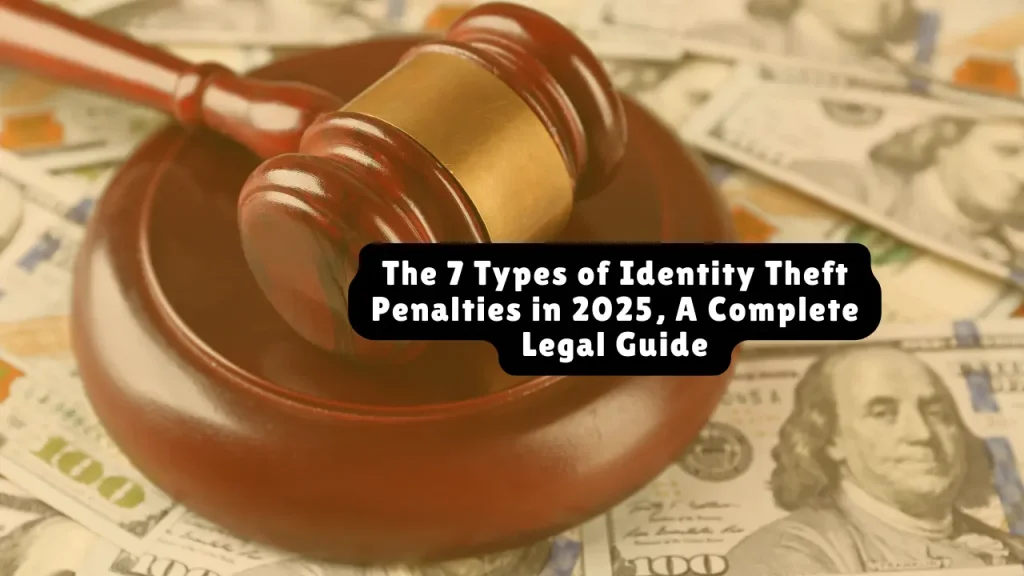7 Types of Identity Theft Penalties in 2025, A Complete Legal Guide
With over 24 million U.S. identity theft victims in 2021 and annual losses exceeding $24 billion, identity theft remains one of the fastest-growing and most damaging crimes in America. In response, federal and state laws have evolved to impose increasingly harsh consequences. This guide explores the seven primary categories of identity theft penalties, including incarceration, fines, restitution, supervised release, and collateral impacts—plus reforms and emerging trends shaping legal outcomes in 2025.
Table of Contents
1. Incarceration: Prison Sentences & Jail Time
Incarceration remains the most severe and common penalty for identity theft. U.S. law differentiates between general and aggravated identity theft, with sentence enhancements based on victim type, scheme scale, and motive.
Federal Law (18 U.S.C. § 1028 & § 1028A)
- General Identity Theft: Up to 15 years for producing fake IDs, stealing personal data, or unauthorized identity use.
- Aggravated Identity Theft (18 U.S.C. § 1028A): Adds a mandatory 2-year sentence, consecutive to any other crime—raised to 5 years if linked to terrorism.
State-Level Penalties
Penalties vary by jurisdiction:
| State | Maximum Incarceration for Identity Theft |
| California | Up to 3 years for felony ID theft (§ 530.5) |
| Florida | Up to 30 years for first-degree felony theft |
| Minnesota | 5–20 years depending on the felony tier |
| New Jersey | 10 years for second-degree wide-scale fraud |
Case Example (2024):
A Virginia man received 12 years in prison for orchestrating a synthetic identity fraud ring using over 400 stolen identities.
2. Financial Penalties: Fines & Restitution
Criminal Fines
- Federal: Up to $250,000 per offense, or twice the gross gain/loss.
- State: Typically $1,000–$10,000. For example, Texas imposes $10,000 for elder-targeted fraud.
Court-Ordered Restitution
Courts mandate repayment for:
- Stolen funds
- Legal costs
- Credit repair expenses
- Lost wages due to identity recovery (e.g., $50/hour × 100 hours)
Notably, some states require restitution even when no direct financial loss is proven.
Real-World Example:
In 2023, a medical identity theft scheme resulted in $120,000 restitution for surgeries fraudulently billed under a stolen identity.
Related article: Minimum Sentences for Identity Theft

3. Probation, Supervised Release & Diversion
For nonviolent or first-time offenders, courts may order probation (state) or supervised release (federal) instead of prison.
Terms & Conditions
- Duration: Typically 1–5 years
- Requirements:
- Mandatory check-ins with probation officers
- Employment mandates
- Internet/computer monitoring
- Curfews and community service
- Mandatory check-ins with probation officers
Violations result in immediate incarceration or sentence extensions.
Diversion & Alternative Sentencing
To reduce recidivism and promote rehabilitation, some states offer:
- Pretrial diversion
- Deferred adjudication
- Restorative justice programs (especially for nonviolent youth offenders)
4. Collateral Consequences: Lifelong Impact
Identity theft convictions carry non-criminal penalties that can profoundly disrupt personal and professional life.
Key Consequences:
- Employment Barriers: 87% of employers reject applicants with felony theft convictions.
- Credit Score Damage: A conviction can lower credit scores by 100+ points for 7+ years.
- Immigration Status: Non-citizens face deportation for identity-theft-related misdemeanors.
- Gun Rights: Felony convictions permanently revoke firearm ownership rights under the Gun Control Act.
- Professional Licensing: Revocations in regulated fields such as finance, medicine, or law.
Real Case:
A tech worker falsely accused of identity theft lost his job despite being acquitted. In 2025, a federal court upheld the employer’s refusal to reinstate him due to reputational risk.
5. Enhanced Penalties: Aggravating Factors
Certain conditions can escalate identity theft sentences, particularly when vulnerable populations or large-scale fraud are involved.
| Aggravating Factor | Penalty Enhancement | Legal Basis |
| Vulnerable Victims | +50% jail time or fines | State elder-abuse & disability laws |
| Large-Scale Schemes | Up to 20+ years in federal prison | Identity Theft Enforcement Act |
| Cross-State Activity | Federal jurisdiction + longer sentences | Wire Fraud Statutes |
| Dark Web Distribution | Up to 25 years in 2025 for SSN vendors | Cybercrime amendments |
6. Civil Liability: Lawsuits from Victims
Victims are increasingly filing civil lawsuits against identity thieves for broader compensation.
Damages Sought:
- Compensatory: Actual losses (money, fees, time)
- Punitive: Up to 3x the actual damage in states like California
- Emotional Distress: Can exceed $100,000 in reputational harm and anxiety
Landmark Case:
In Doe v. PhishMaster (2024), victims of a phishing-driven identity theft ring were awarded $2.1 million in civil damages.
7. Administrative & Professional Sanctions
Regulatory bodies and the FTC impose non-criminal sanctions on identity-theft offenders:
Examples:
- License Revocation: CPAs, doctors, and financial advisors lose credentials
- Employment Bans: Barred from regulated industries like banking or healthcare
- Cease-and-Desist Orders: FTC may ban e-commerce activities
Case Study: A certified public accountant (CPA) lost her license after using client SSNs to fraudulently apply for credit.
Additional Penalties by Offense Type
Some crimes have offense-specific penalties written into law:
| Offense Type | Penalty |
| Tax Identity Theft | 26 U.S.C. § 7206 & § 7207 → Up to 3 years, $100,000 fine |
| Medical Fraud | Federal Medicaid statutes → Up to 10 years |
| Child ID Theft | Enhanced felony classification and restitution in many states |
Recent Trends & Reform Efforts (2025)
The identity theft penalty landscape is evolving to reflect modern fraud tactics and fairness reforms:
- Diversion programs expanded for low-level, nonviolent offenders.
- Restorative justice emphasized in youth and first-time cases.
- State law updates now target synthetic identity theft and deepfake scams.
- Debates over mandatory minimums aim to restore judicial discretion.
Expert Insight
“Synthetic identity theft now drives over 70% of total fraud losses. Prosecutors use ‘aggregated loss’ methods—turning a $5,000 scam involving 50 victims into a $250,000 felony case.”
— Shai Cohen, SVP, TransUnion
Prevention for Victims & Defense for the Accused
For Potential Victims:
- Credit Freeze via Equifax, Experian, and TransUnion
- IRS IP PIN to block tax-related identity fraud
- Use Monitoring Services like LifeLock, Aura, or IdentityGuard
For the Accused:
- Challenge Intent: Prove no criminal purpose (e.g., mistaken use of SSN)
- Suppress Illegally Obtained Evidence
- Negotiate Restitution: Pre-trial repayment can reduce sentencing by up to 40%
Conclusion: Identity Theft Penalties Redefine Futures
In 2025, identity theft penalties reach far beyond fines and prison terms. The damage can last decades—eroding careers, credit, and civil rights. Whether you’re a victim or facing charges, understanding the full spectrum of consequences and remedies is critical.
Key Takeaways:
- Federal penalties include 15 years’ imprisonment and $250K fines.
- State laws may impose up to 30 years and $10K fines.
- Restitution and lawsuits can result in six- to seven-figure damages.
- Collateral consequences often outlast criminal sentences.
- Defendants should act early, leveraging restitution and legal defenses.
- Victims should document everything via FTC IdentityTheft.gov.
About the Author

Sarah Klein, JD, is a former consumer rights attorney who spent years helping clients with issues like unfair billing, product disputes, and debt collection practices. At All About Lawyer, she simplifies consumer protection laws so readers can defend their rights and resolve problems with confidence.
Read more about Sarah

thank you for this I am just being to see what has been going on
Our Pleasure, Let us know if you want us to cover more topics